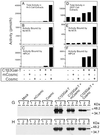A unique molecular chaperone Cosmc required for activity of the mammalian core 1 beta 3-galactosyltransferase
- PMID: 12464682
- PMCID: PMC139192
- DOI: 10.1073/pnas.262438199
A unique molecular chaperone Cosmc required for activity of the mammalian core 1 beta 3-galactosyltransferase
Abstract
Human core 1 beta3-galactosyltransferase (C1beta3Gal-T) generates the core 1 O-glycan Galbeta1-3GalNAcalpha1-SerThr (T antigen), which is a precursor for many extended O-glycans in animal glycoproteins. We report here that C1beta3Gal-T activity requires expression of a molecular chaperone designated Cosmc (core 1 beta3-Gal-T-specific molecular chaperone). The human Cosmc gene is X-linked (Xq23), and its cDNA predicts a 318-aa transmembrane protein ( approximately 36.4 kDa) with type II membrane topology. The human lymphoblastoid T cell line Jurkat, which lacks C1beta3Gal-T activity and expresses the Tn antigen GalNAcalpha1-SerThr, contains a normal gene and mRNA encoding C1beta3Gal-T, but contains a mutated Cosmc with a deletion introducing a premature stop codon. Expression of Cosmc cDNA in Jurkat cells restored C1beta3Gal-T activity and T antigen expression. Without Cosmc, the C1beta3Gal-T is targeted to proteasomes. Expression of active C1beta3Gal-T in Hi-5 insect cells requires coexpression of Cosmc. Overexpression of active C1beta3Gal-T in mammalian cell lines also requires coexpression of Cosmc, indicating that endogenous Cosmc may be limiting. A small portion of C1beta3Gal-T copurifies with Cosmc from cell extracts, demonstrating physical association of the proteins. These results indicate that Cosmc acts as a specific molecular chaperone in assisting the foldingstability of C1beta3Gal-T. The identification of Cosmc, a uniquely specific molecular chaperone required for a glycosyltransferase expression in mammalian cells, may shed light on the molecular basis of acquired human diseases involving altered O-glycosylation, such as IgA nephropathy, Tn syndrome, Henoch-Schönlein purpura, and malignant transformation, all of which are associated with a deficiency of C1beta3Gal-T activity.
Figures




References
-
- Wells L., Gao, Y., Mahoney, J. A., Vosseller, K., Chen, C., Rosen, A. & Hart, G. W. (2002) J. Biol. Chem. 277, 1755-1761. - PubMed
-
- Brockhausen I., Schutzbach, J. & Kuhns, W. (1998) Acta Anat. (Basel) 161, 36-78. - PubMed
-
- Ju T., Brewer, K., D'Souza, A., Cummings, R. D. & Canfield, W. M. (2002) J. Biol. Chem. 277, 178-186. - PubMed
-
- Ju T., Cummings, R. D. & Canfield, W. M. (2002) J. Biol. Chem. 277, 169-177. - PubMed
Publication types
MeSH terms
Substances
Associated data
- Actions
- Actions
Grants and funding
LinkOut - more resources
Full Text Sources
Other Literature Sources
Molecular Biology Databases
Miscellaneous

